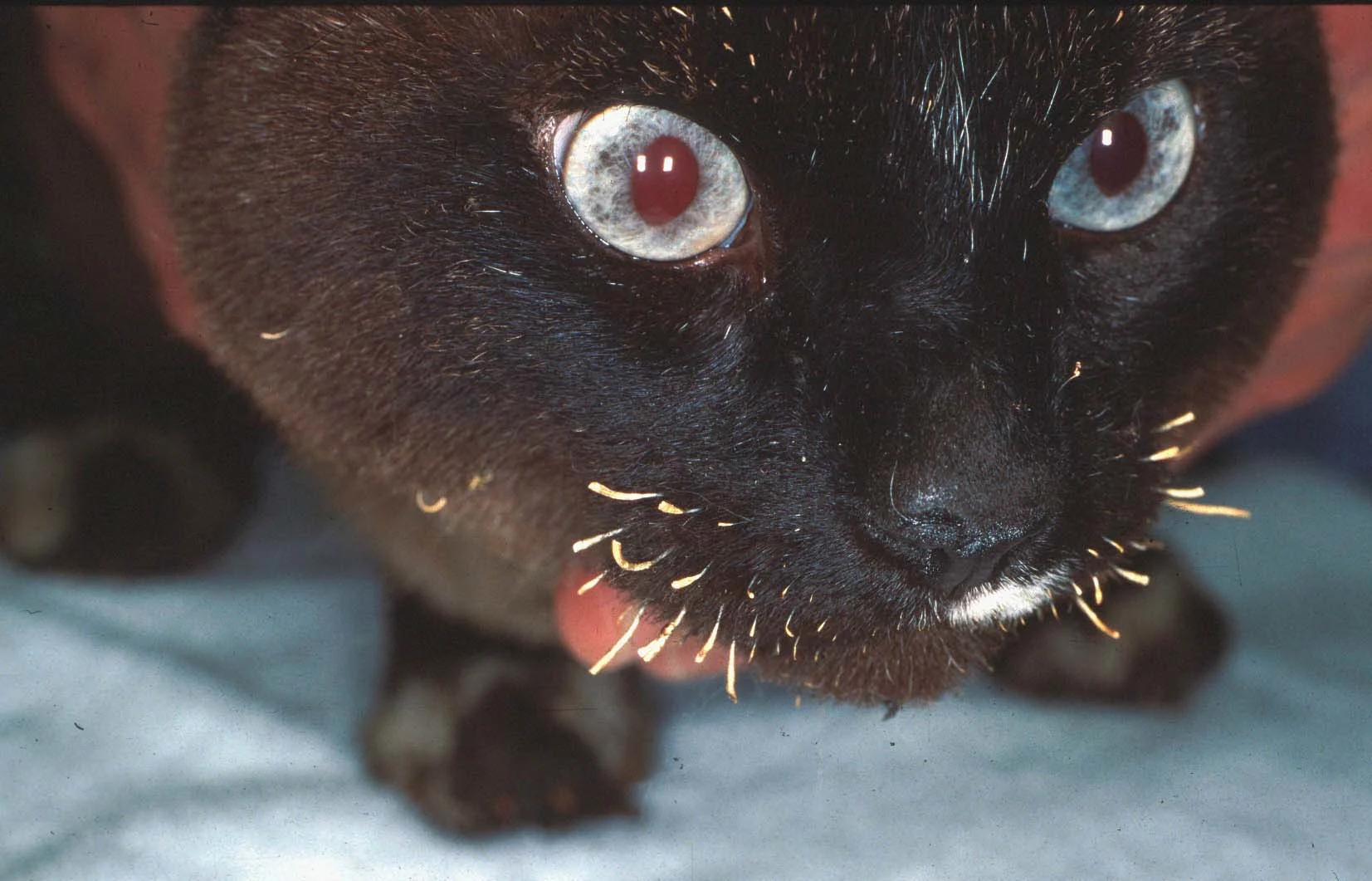Cat in a House Fire
Karen A. Moriello, DVM, DACVD, University of Wisconsin–Madison
Rosemary Henik, DVM, MS, Diplomate ACVIM, University of Wisconsin

A five-year-old male Siamese cat named Grizzly was brought to the Veterinary Medical Teaching Hospital by a police officer after having been rescued from a house fire.
History
When an unattended candle in the cat's home started a fire that rapidly engulfed the second story, Grizzly ran to the unfinished attic. Insulation beneath the attic floorboards caught fire, melting the linoleum above and filling the attic with smoke. During a routine search for possible human victims, a firefighter found the meowing cat, huddled on the floor, unable to move because of melted linoleum beneath its body. To free the cat, rescuers used a box cutter to cut the flooring and transported him for emergency care still adhered to the melted flooring.
Physical Examination
The cat was alert and meowing. He immediately received analgesics, intravenous fluid therapy, and supplemental oxygen via a mask while being assessed for thermal shock and respiratory injuries. Auscultation of the heart and lungs was normal. The cat's oral cavity, eyes, and ears were normal, but his vibrissae were singed (Figure 1). The clinician on duty was able to remove the linoleum from the cat using soft butter on gauze and gentle traction. Some material remained on the paws and ventrum of the abdomen. All four paws were burned but, because of the larger surface area, the rear paws were more severely burned (Figure 2). The hair on the ventral abdomen was singed and matted with melted linoleum (Figure 3). The cat was not in thermal shock and there was no apparent respiratory compromise in spite of the fact that the cat had been in a smoke-filled room. The cat was able to move its paws and digits.

FIGURE 1
Ask Yourself ...
Treatment
Once the cat was stable, the hair coat was clipped to assess the extent of his burns, particularly on the ventral abdomen. Because thermal damage to the tissue can and will continue even after the thermal source has been removed, the cat was soaked in cold water for 30 minutes to help prevent the burns from progressing (Figure 4). Application of cold also provides analgesia. This treatment was surprisingly well tolerated by the cat. Care must be taken to avoid hypothermia.1

Soaking to minimize continuation of burn and to remove debris
Infection is one of the most common complications in burn patients. Several considerations are important when selecting a topical antibacterial. First, it must be easily removed (ie, water miscible) because bandages will be changed at least daily. Second, agents that penetrate the burn eschar should be used. Third, the risk of systemic absorption of the antibiotic and/or the base must be considered. Mupirocin ointment is an excellent choice but there have been anecdotal reports of cats developing renal failure, presumably associated with absorption of the propylene glycol base. Aminoglycoside-containing products may pose a nephrotoxic risk depending upon the extent of the lesion and the amount applied over time.
Finally, it is important that the topical product is soothing rather than pain producing when applied. Silver sulfadiazine, a water-soluble ointment commonly used to treat burns, does not sting and penetrates eschar. It is not inactivated by organic debris and has a wide spectrum of activity, particularly against Pseudomonas spp. In this case, daily bandage changes and tissue soaking facilitated removal of any residual linoleum and necrotic tissue. Minimal debridement was needed.
Respiratory Injury
Although the cat's respiratory status was stable at presentation, oxygen therapy and intensive monitoring of respiratory rate and effort were continued over the first 24 hours. Laryngeal edema, bronchoconstriction, or respiratory infection may develop during the first several days following smoke inhalation. Similarly, thoracic radiographs that are initially unremarkable may become abnormal over the first 24 to 48 hours. Although this patient had singed whiskers, no other evidence of oral, airway, or lung injury was present, nor did any respiratory disease develop during hospitalization.
Observations & Outcome
This cat suffered burns over less than 10% of his body. The burns on the ventral abdomen were superficial. Superficial burns involve only the epidermis and are characterized by erythema and eventual scaling.1 The skin may appear thickened. The burns on the hind paws were mostly superficial with deep partial thickness burns in focal areas. The cat had movement of the paws and digits, indicating that there was not irreparable damage to tissue. Focal areas of eschar sloughed and the burns healed by contraction and reepithelialization. No surgical intervention was needed and the cat recovered uneventfully.
Burns in small animals are uncommon but occur most often from fires, dryers, heating pads, stoves, heat lamps, boiling water, sun exposure, and hot radiant heat sources.2 In northern climates, radiant burns from wood stoves, space heaters, and fireplaces are underrecognized. These burns, which have a "drip-like" configuration, occur from repetitive exposure to heat. The owner never sees the animal get burned and the hair coat obscures the hair loss and erythema. In some cases, all that is noticed is "hard skin" under the hair coat. Definitive diagnosis is made by biopsy.
Take-Home Messages
Cold pack burns for 5-30 minutes to prevent progression of the burn.
The full extent of the burn may not be evident for up to 7-10 days.
Petroleum-based products like tar can be removed from the hair coat or wounds by using butter in an almost liquid state on a gauze sponge.1
The wounds should be debrided as soon as possible because the eschar skin frequently becomes colonized with bacteria. Early debridement prevents this, particularly where the burns are small.
Use silver sulfadiazine ointment as a topical antibacterial under bandages because it is water-soluble, penetrates into necrotic tissue, has a wide spectrum of activity, and does not sting upon application.
Change bandages daily and lavage and debride as needed.
Burns in northern climates may be an underdiagnosed cause of mysterious drip-like erythematous areas of hair loss.